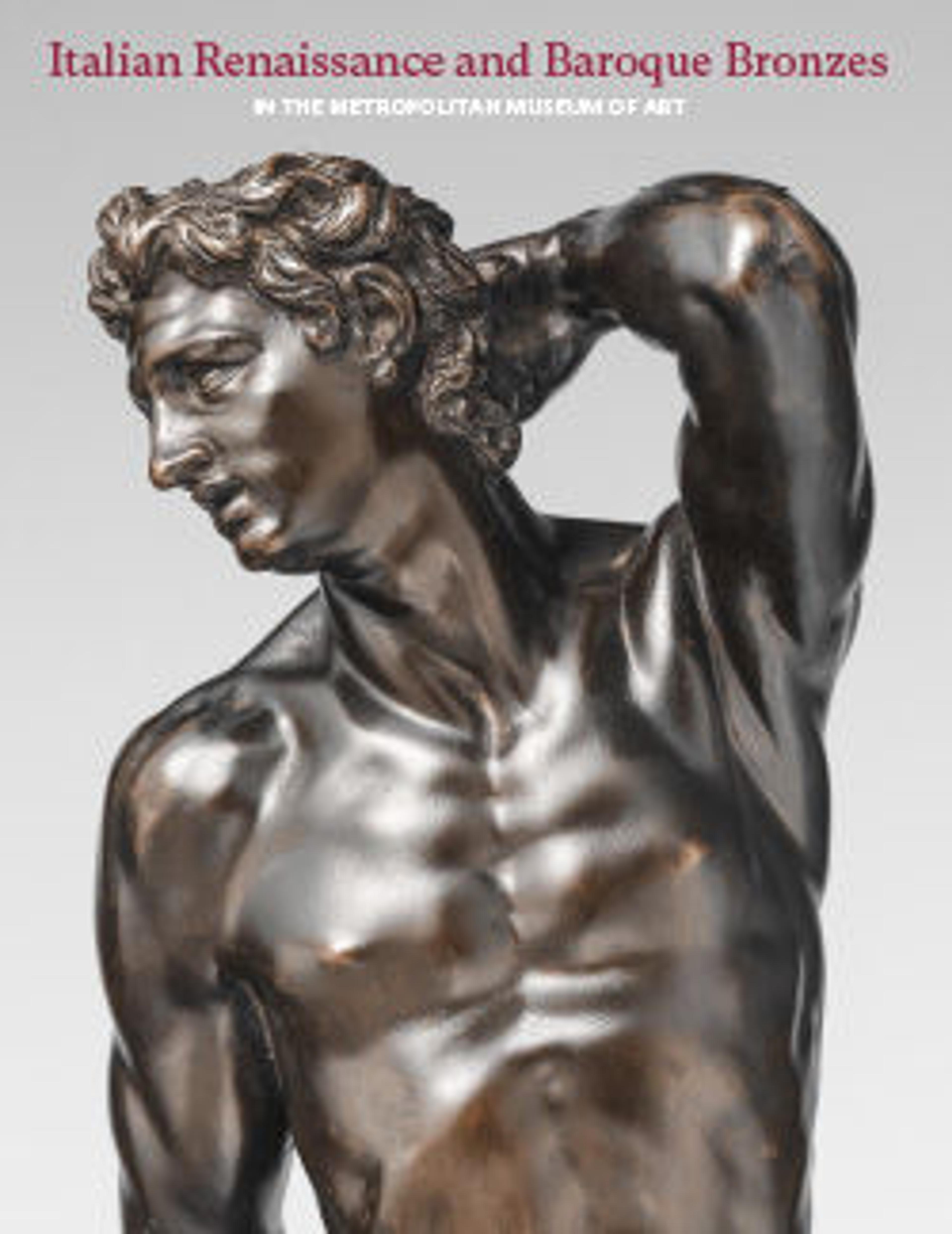David with the head of Goliath
By the mid-sixteenth century, Severo’s shop was already in decline, and the downturn in quality of its output is painfully obvious.[1] The modeler knew our Bellano David (cat. 2) as well as that in the Philadelphia Museum of Art, which we attribute to Severo (see p. 00, fig. 2a), but apparently at some remove. An inscription, MARCO.ANTonio.RAVenna F.G.F., occurs on a slightly better example in the National Museum of Scotland, Edinburgh, introduced into the literature by Patrick De Winter, who notes a Marcantonio at work in the cloister of Santa Maria in Porto, Ravenna, in 1506.[2] Severo’s relations have otherwise gone unnamed, but Marcantonio may well have been among them.
The shop’s takeoffs on the Davids of Bellano and Severo take two forms: a broad-browed youth of greater allure, represented by a good statuette in the V&A,[3] and a more widespread type including ours, where the hero reflects upon an absurdly small head of Goliath while feebly wielding a sword. Ours is a scimitar, but the weapons vary.[4] Richard Stone notes that the positioning of plugs in the rear of the shoulders is characteristic of Severo’s figures when clothed.[5]
-JDD
Footnotes
(For key to shortened references see bibliography in Allen, Italian Renaissance and Baroque Bronzes in The Metropolitan Museum of Art. NY: The Metropolitan Museum of Art, 2022.)
1. For the late production of Severo’s workshop, see Warren 2014, p. 140.
2. De Winter 1986, p. 121, figs. 122, 123. Radcliffe 1986, p. 185, doubts the inscription is a signature but more likely records the name of an owner. The present writer’s recollection is that the letters were cast-in and thus probably original.
3. V&A, 593-1865; see De Winter 1986, p. 106, fig. 74 (to Severo and workshop). A good one was in the Abbott Guggenheim collection (Camins 1988, cat. 4).
4. See De Winter 1986, p. 138 n. 79, for a list of casts.
5. Stone 2006, pp. 813–14, fig. 8.
The shop’s takeoffs on the Davids of Bellano and Severo take two forms: a broad-browed youth of greater allure, represented by a good statuette in the V&A,[3] and a more widespread type including ours, where the hero reflects upon an absurdly small head of Goliath while feebly wielding a sword. Ours is a scimitar, but the weapons vary.[4] Richard Stone notes that the positioning of plugs in the rear of the shoulders is characteristic of Severo’s figures when clothed.[5]
-JDD
Footnotes
(For key to shortened references see bibliography in Allen, Italian Renaissance and Baroque Bronzes in The Metropolitan Museum of Art. NY: The Metropolitan Museum of Art, 2022.)
1. For the late production of Severo’s workshop, see Warren 2014, p. 140.
2. De Winter 1986, p. 121, figs. 122, 123. Radcliffe 1986, p. 185, doubts the inscription is a signature but more likely records the name of an owner. The present writer’s recollection is that the letters were cast-in and thus probably original.
3. V&A, 593-1865; see De Winter 1986, p. 106, fig. 74 (to Severo and workshop). A good one was in the Abbott Guggenheim collection (Camins 1988, cat. 4).
4. See De Winter 1986, p. 138 n. 79, for a list of casts.
5. Stone 2006, pp. 813–14, fig. 8.
Artwork Details
- Title: David with the head of Goliath
- Artist: After a model by Severo Calzetta da Ravenna (Italian, active by 1496, died before 1543)
- Date: mid-16th century
- Culture: Italian, Ravenna or Padua
- Medium: Bronze
- Dimensions: Overall (confirmed): 10 3/4 × 4 1/2 × 2 3/4 in. (27.3 × 11.4 × 7 cm)
- Classification: Sculpture-Bronze
- Credit Line: Gift of Irwin Untermyer, 1964
- Object Number: 64.101.1411
- Curatorial Department: European Sculpture and Decorative Arts
More Artwork
Research Resources
The Met provides unparalleled resources for research and welcomes an international community of students and scholars. The Met's Open Access API is where creators and researchers can connect to the The Met collection. Open Access data and public domain images are available for unrestricted commercial and noncommercial use without permission or fee.
To request images under copyright and other restrictions, please use this Image Request form.
Feedback
We continue to research and examine historical and cultural context for objects in The Met collection. If you have comments or questions about this object record, please contact us using the form below. The Museum looks forward to receiving your comments.
